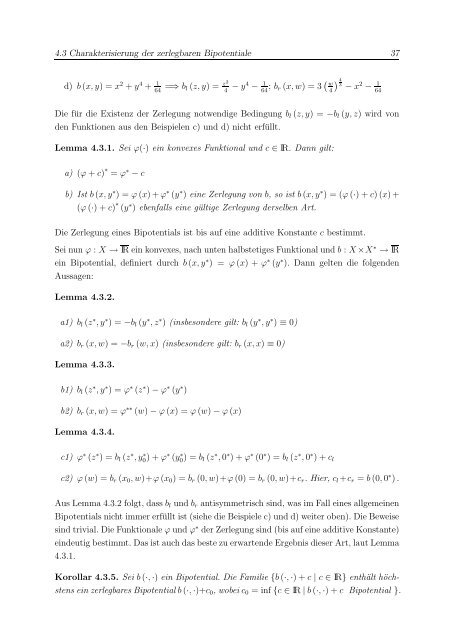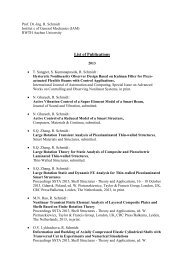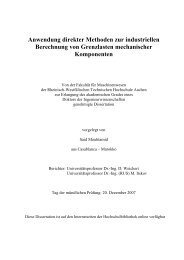Anwendungen der getrennt konvexen Funktionale in der Mechanik
Anwendungen der getrennt konvexen Funktionale in der Mechanik
Anwendungen der getrennt konvexen Funktionale in der Mechanik
Sie wollen auch ein ePaper? Erhöhen Sie die Reichweite Ihrer Titel.
YUMPU macht aus Druck-PDFs automatisch weboptimierte ePaper, die Google liebt.
4.3 Charakterisierung <strong>der</strong> zerlegbaren Bipotentiale 37d) b (x, y) = x 2 + y 4 + 1 =⇒ b 64 l (z, y) = z2 − 4 y4 − 1 ; b 64 r (x, w) = 3 ( )4w 3− x 2 − 14 64Die für die Existenz <strong>der</strong> Zerlegung notwendige Bed<strong>in</strong>gung b l (z, y) = −b l (y, z) wird vonden Funktionen aus den Beispielen c) und d) nicht erfüllt.Lemma 4.3.1. Sei ϕ(·) e<strong>in</strong> konvexes Funktional und c ∈ IR. Dann gilt:a) (ϕ + c) ∗ = ϕ ∗ − cb) Ist b (x, y ∗ ) = ϕ (x)+ϕ ∗ (y ∗ ) e<strong>in</strong>e Zerlegung von b, so ist b (x, y ∗ ) = (ϕ (·) + c) (x)+(ϕ (·) + c) ∗ (y ∗ ) ebenfalls e<strong>in</strong>e gültige Zerlegung <strong>der</strong>selben Art.Die Zerlegung e<strong>in</strong>es Bipotentials ist bis auf e<strong>in</strong>e additive Konstante c bestimmt.Sei nun ϕ : X → IR e<strong>in</strong> konvexes, nach unten halbstetiges Funktional und b : X ×X ∗ → IRe<strong>in</strong> Bipotential, def<strong>in</strong>iert durch b (x, y ∗ ) = ϕ (x) + ϕ ∗ (y ∗ ). Dann gelten die folgendenAussagen:Lemma 4.3.2.a1) b l (z ∗ , y ∗ ) = −b l (y ∗ , z ∗ ) (<strong>in</strong>sbeson<strong>der</strong>e gilt: b l (y ∗ , y ∗ ) ≡ 0)a2) b r (x, w) = −b r (w, x) (<strong>in</strong>sbeson<strong>der</strong>e gilt: b r (x, x) ≡ 0)Lemma 4.3.3.b1) b l (z ∗ , y ∗ ) = ϕ ∗ (z ∗ ) − ϕ ∗ (y ∗ )b2) b r (x, w) = ϕ ∗∗ (w) − ϕ (x) = ϕ (w) − ϕ (x)Lemma 4.3.4.c1) ϕ ∗ (z ∗ ) = b l (z ∗ , y ∗ 0 ) + ϕ∗ (y ∗ 0 ) = b l (z ∗ , 0 ∗ ) + ϕ ∗ (0 ∗ ) = b l (z ∗ , 0 ∗ ) + c lc2) ϕ (w) = b r (x 0 , w)+ϕ (x 0 ) = b r (0, w)+ϕ (0) = b r (0, w)+c r . Hier, c l +c r = b (0, 0 ∗ ).Aus Lemma 4.3.2 folgt, dass b l und b r antisymmetrisch s<strong>in</strong>d, was im Fall e<strong>in</strong>es allgeme<strong>in</strong>enBipotentials nicht immer erfüllt ist (siehe die Beispiele c) und d) weiter oben). Die Beweises<strong>in</strong>d trivial. Die <strong>Funktionale</strong> ϕ und ϕ ∗ <strong>der</strong> Zerlegung s<strong>in</strong>d (bis auf e<strong>in</strong>e additive Konstante)e<strong>in</strong>deutig bestimmt. Das ist auch das beste zu erwartende Ergebnis dieser Art, laut Lemma4.3.1.Korollar 4.3.5. Sei b (·, ·) e<strong>in</strong> Bipotential. Die Familie {b (·, ·) + c | c ∈ IR} enthält höchstense<strong>in</strong> zerlegbares Bipotential b (·, ·)+c 0 , wobei c 0 = <strong>in</strong>f {c ∈ IR | b (·, ·) + c Bipotential }.














